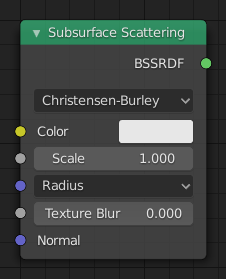次表面散射 (SSS)¶

Subsurface Scattering Shader.¶
次表面散射 节点用于为诸如面板,蜡,大理石,牛奶等材质添加简单的次表面多次散射效果。对于上述材质,光线不会直接从表面反射,而是会穿透表面并在内部反弹,然后被吸收或离开表面到达附近的点。
可以根据RGB颜色通道配置颜色散布的平均距离。例如,对于面板,红色会进一步散射,从而产生独特的红色阴影和柔和的外观。
输入¶
- 颜色
物体表面的颜色,从物理学角度讲,既光线中的不同波长被反射的概率。
- 比例|缩放
散射半径的全局全局缩放系数。
- 半径
光散射到表面下方的平均距离。较高的半径可以使外观更柔和,因为光线会流入阴影区域并穿过物体。散射距离是针对RGB通道单独指定的,对于具有较强红光散射的面板材质,渲染效果较佳。X,Y和Z的数值会分别映射到R,G和B的值。
- 锐度
Used only with Cubic falloff. Values increasing from 0 to 1 prevents softening of sharp edges and reduces unwanted darkening.
- 法线
用于着色的法向;如果没有连接其它选项,则使用默认着色法向。
- Texture Blur
How much of the texture will be blurred along with the lighting, mixing the texture at the incoming and outgoing points on the surface. Note that the right choice depends on the texture. Consider for example a texture created from a photograph of skin, in this case the colors will already be pre-blurred and texture blur could be set to 0. Even for hand-painted textures, no blurring or minimal blurring might be appropriate, as a texture artist would likely paint in softening already. One would usually not even know what an unblurred skin texture looks like; we always see it blurred. For a procedural texture on the other hand this option would likely have a higher value.
属性¶
- 衰减
模拟次表面散射的渲染方式。
- 三次型
Is a sharp falloff useful for many simple materials. The function is \((radius - x)^3\).
- 高斯
Gives a smoother falloff following a normal distribution, which is particularly useful for more advanced materials that use measured data that was fitted to one or more such Gaussian functions. The function is \(e^{-8x^2/ radius^2}\), such that the radius roughly matches the maximum falloff distance. To match a given measured variance v, set \(radius = sqrt(16 × v)\).
- 克里斯坦森-伯利
Is an approximation to physically-based volume scattering. Gives less blurry results than Cubic and Gaussian functions.
- 随机游走
Cycles Only Provides the most accurate results for thin and curved objects. This comes at the cost of increased render time or noise for more dense media like skin, but also better geometry detail preservation. Random Walk uses true volumetric scattering inside the mesh, which means that it works best for closed meshes. Overlapping faces and holes in the mesh can cause problems.
输出¶
- BSSRDF
BSSRDF shader output.
